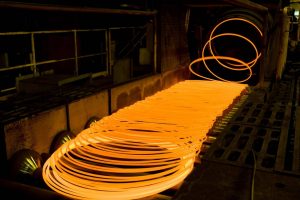
Heat Treating 1018 Steel
Heat Treating 1018 Steel
Can 1018 steel be hardened? Yes. It is possible to case harden 1018 steel. Case hardening is where the inner core of the material does not get hard, but the outer edge of the material develops a
case” or becomes hard.
The chemical property of steel you want to heat treat is critical, and close attention must be paid to it. 1018 steel has low carbon content, 0.18 percent, making it softer than other steels. Low-carbon steels are described as “mild.” 1018 is suitable for production of screw propulsion systems, worm gears, rods and pistons. 1018 can be annealed and hardened but cannot be tempered due to not having enough carbon. The term 1018 is often used by laymen to describe any mild steel, even though not all mild steel is 1018. Below we offer a brief description of 1018 steel heat treatment.
Hardening
1018 can be case hardened or super quenched. Case hardening requires burying the steel in a metal box full of powdered carbon. According to our information, the box is then heated to red-orange (1,700 to 1,800 degrees Fahrenheit) for one to 16 hours, depending on how deep into the metal you desire the case to go. The metal can then be allowed to air cool or it can be quenched while still at peak temperature.
Super Quench
Although 1018 steel cannot be hardened to the extent that high-carbon steel can, historical tactics used to increase its hardness included lye and mercury quenching, which are extremely toxic. After lye and mercury quenching were banned by the government, Robb Gunter of Sandia Labs invented “Super Quench.” Super quench combines several easily obtained household chemicals to mimic the effects of the older, hazardous mercury and lye quenches without the physical risks and environmental damage.
Super Quench prevents the formation of a protective steam jacket around the steel by changing the surface tension of the water. This results in faster cooling. Super Quench brings 1018 steel to its maximum hardness but can create extreme warpage in thin or long parts, which must be hammer or press straightened while cold. Usually 1018 can be brought up to a hardness in the low 40s Rockwell-C scale range using this technique.
Considerations
Hardening and case hardening results will vary drastically depending on the actual type of mild steel you are using. If the parts are important enough to harden, it is best to make sure of your steel designation. The only way to be absolutely sure that you have 1018 steel is to purchase it as 1018 from a steel supply company or to have a spectrographic analysis performed. Since spectrographic analysis is expensive, most metalworkers rely on destruction tests instead. If you do not know the actual designation number of the steel your are using, perform destruction tests before you are forced to scrap valuable pieces.
Metallurgy
An understanding of the properties of 1018 steel in particular and the phases of steel during heat treatment is important if the steel is being used to create precision parts. Improper heat treating 1018 steel can result in early metal fatigue and failure of the part at a critical moment. Steel that is repeatedly subjected to rapid temperature changes, as in engine or machine parts, can become brittle, crack and shear apart. This damage is often not apparent in a simple visual inspection but requires microscopic testing to determine if a given part is in danger of failure.
Additional Reading
Most of the technical terms used in this article can explained in greater detail by the Carlson Manufacturing Design Team. With over 50 years of experience, they are a great manufacturing resource. They have been of assistance in examining and diagnosing failed parts. While they do not specialize in forensic examination of failed parts, they have decades of experience working with a wide variety of companies to diagnose the best manufacturing solutions and the causes of common parts failure. They are able to assist in matters involving questions of heat treatment on steel structure, explains the phases steel undergoes and describes the properties it acquires through heat treatment. Additional information on the metallurgy behind heat treating 1018 steel can be found at Carlson Manufacturing, Inc.
